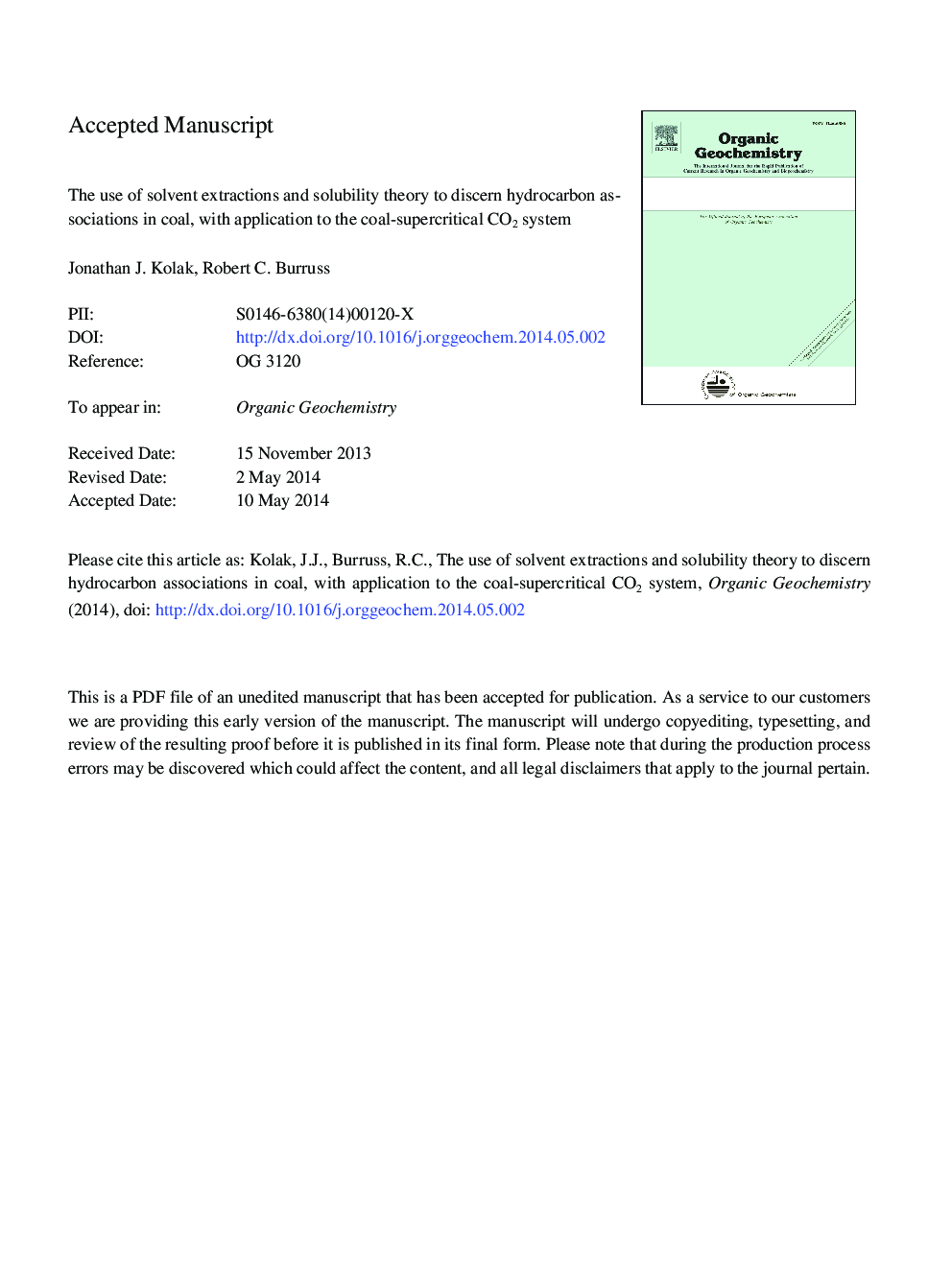| کد مقاله | کد نشریه | سال انتشار | مقاله انگلیسی | نسخه تمام متن |
|---|---|---|---|---|
| 5162409 | 1502288 | 2014 | 43 صفحه PDF | دانلود رایگان |
عنوان انگلیسی مقاله ISI
The use of solvent extractions and solubility theory to discern hydrocarbon associations in coal, with application to the coal-supercritical CO2 system
دانلود مقاله + سفارش ترجمه
دانلود مقاله ISI انگلیسی
رایگان برای ایرانیان
کلمات کلیدی
موضوعات مرتبط
مهندسی و علوم پایه
شیمی
شیمی آلی
پیش نمایش صفحه اول مقاله

چکیده انگلیسی
Samples of three high volatile bituminous coals were subjected to parallel sets of extractions involving solvents dichloromethane (DCM), carbon disulfide (CS2), and supercritical carbon dioxide (CO2) (40 °C, 100 bar) to study processes affecting coal-solvent interactions. Recoveries of perdeuterated surrogate compounds, n-hexadecane-d34 and four polycyclic aromatic hydrocarbons (PAHs), added as a spike prior to extraction, provided further insight into these processes. Soxhlet-DCM and Soxhlet-CS2 extractions yielded similar amounts of extractable organic matter (EOM) and distributions of individual hydrocarbons. Supercritical CO2 extractions (40 °C, 100 bar) yielded approximately an order of magnitude less EOM. Hydrocarbon distributions in supercritical CO2 extracts generally mimicked distributions from the other solvent extracts, albeit at lower concentrations. This disparity increased with increasing molecular weight of target hydrocarbons. Five- and six-ring ring PAHs generally were not detected and no asphaltenes were recovered in supercritical CO2 extractions conducted at 40 °C and 100 bar. Supercritical CO2 extraction at elevated temperature (115 °C) enhanced recovery of four-ring and five-ring PAHs, dibenzothiophene (DBT), and perdeuterated PAH surrogate compounds. These results are only partially explained through comparison with previous measurements of hydrocarbon solubility in supercritical CO2. Similarly, an evaluation of extraction results in conjunction with solubility theory (Hildebrand and Hansen solubility parameters) does not fully account for the hydrocarbon distributions observed among the solvent extracts. Coal composition (maceral content) did not appear to affect surrogate recovery during CS2 and DCM extractions but might affect supercritical CO2 extractions, which revealed substantive uptake (partitioning) of PAH surrogates into the coal samples. This uptake was greatest in the sample (IN-1) with the highest vitrinite content. These findings indicate that hydrocarbon solubility does not exert a strong influence on hydrocarbon behavior in the systems studied. Other factors such as coal composition and maceral content, surface processes (physisorption), or other molecular interactions appear to affect the partitioning of hydrocarbons within the coal-supercritical CO2 system. Resolving the extent to which these factors might affect hydrocarbon behavior under different geological settings is important to efforts seeking to model petroleum generation, fractionation and expulsion from coal beds and to delineate potential hydrocarbon fate and transport in geologic CO2 sequestration settings.
ناشر
Database: Elsevier - ScienceDirect (ساینس دایرکت)
Journal: Organic Geochemistry - Volume 73, August 2014, Pages 56-69
Journal: Organic Geochemistry - Volume 73, August 2014, Pages 56-69
نویسندگان
Jonathan J. Kolak, Robert C. Burruss,